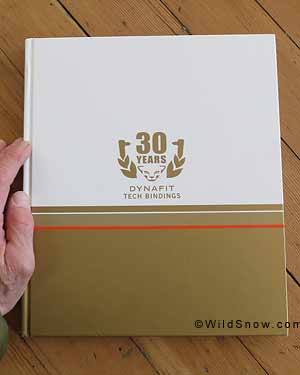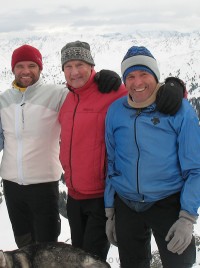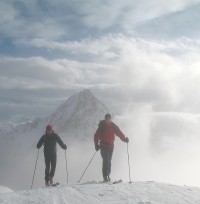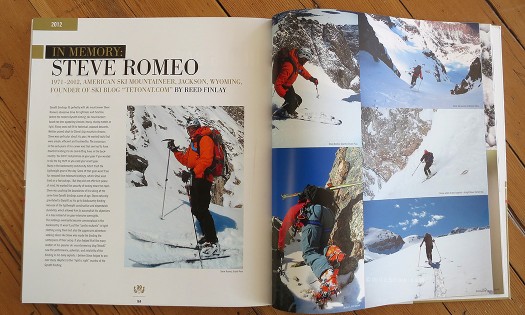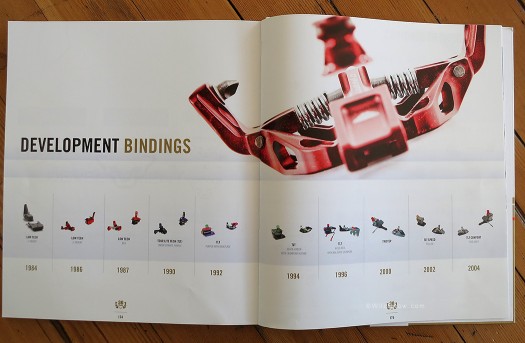Weight is everything. Strap the ounces, pounds and grams on your feet–double the above statement.
When Fritz Barthel patented his concept for a frameless ski touring binding in 1984, he did so with the incentive of saving weight. The mechanical engineer had been on an exhausting ski climb of Mt. Blanc. He’d used huge boots as heavy as concrete buckets paired with massive plate bindings. Others were doing such peaks with such gear, but in Fritz’s own words “laziness is the mother of invention.”
Little did Fritz know his frameless “Low Tech” binding would set the sport of ski mountaineering on its ear. Soon, combined with a ground-breaking Dynafit brand lightweight touring boot (original red model ‘Tourlite’), the system saved so much weight and added so much efficiency it started a revolution. Ski touring and “ski rally racing” speeded up. Or more importantly, got funner, safer, easier.
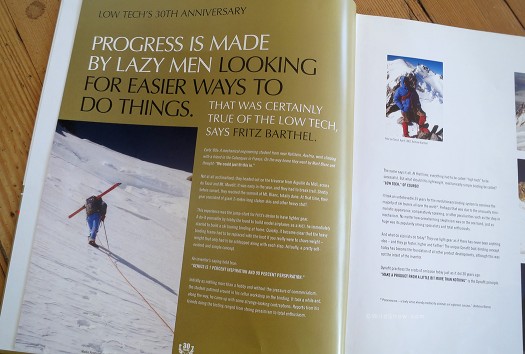
Dynafit history book begins with focus on tech binding inventor Fritz Barthel, but goes on with dozens of personal accounts from binding users over the years (including a short blurb from myself).
Barthel’s invention is still resonating in the industry like some kind of infinite echo. Amazingly, most tech bindings today are either nearly direct copies of Barthel bindings of almost 30 years ago, or close to it. Just think; 1984 was when the first Macintosh computer was introduced — it wouldn’t be till the next year that the first .com domain name was registered and the internet as we know it was born.
The invention of the tech binding was to ski touring what the invention of the internet was to everything else. Seriously.
At any rate, Barthel eventually was dealing with thousands of pairs of Dynafit Tour-Lite model ski boots in his family home and basement workshop, where he and a group of friends installed the boot heel fittings by hand. Unsustainable. More, by selling his boots direct to Italy he was infringing on a previous business agreement that the Dynafit company had with an Italian distributor. So Fritz licensed his patent to the Dynafit boot company that molded the fittings into the boots and commercialized the binding. Business convolutions ensued resulting in EU outdoors gear giant Salewa acquiring the Dynafit brand around 2003 and subsequently building the current fully vertical line of Dynafit branded ski touring products.
Fast forward to this year, 2014, thirty years after Fritz was awarded Austrian patent NR. 376577. The original patent has expired (which is what allows so many different companies to make tech bindings). More tech bindings are on the market than anyone can count. Without ever becoming an “official” (DIN/ISO) standard, the tech system is a virtual standard that dozens of brands are attempting to produce conforming products for.
Yep, year 2014 is the (Dynafit née Low Tech) binding’s 30th birthday. Nice to be popular and have a lot of people attend the party!
I’d like to interject here that Fritz and I have become good friends. (What is more, he and his family are a big reason WildSnow.com is what it is, due to their support while we’re in Europe as well as just getting to know a family of true Tiroleans.) As a result I’ve been privy to quite a bit of back story, most of which shall remain deep background unless Fritz chooses to share. But I want to make the point that product development of this sort is not all roses.
Some of the challenges Fritz and subsequently other Dynafit binding engineers have dealt with have been psyche blasting sagas. Mainly, such problems came (and still come from) forcing a machine to do what a ski binding does, only with incredibly minimal parts. Thus, materials science comes into play just as much as the mechanical hinges and catches of a better mousetrap. (For the record, Fritz does not work as a Dynafit employee, but as a consultant and contract worker, what he terms an “external associate.”)
For example, consider the pins that hold your boot heel in a tech binding. These tiny steel rods have to be made of exactly the right steel, heat treated perfectly, and plated perfectly. Otherwise they will break or wear out. And indeed they have (not only has Dynafit had this problem, but other tech binding makers have as well).
Some years ago during one such “saga of the pins,” the binding worked perfectly in post production testing with the heel pins showing triple 9 durability. Then somehow the manufacturer of the heel pins was changed at the same time the binding began factory-assembly and retail sales. Long story short, the pins were made incorrectly, and many broke for end-users of the binding. A dangerous and embarrassing situation. I heard the story first-hand about how much worry and sleuthing was required to figure this problem out, and how difficult it was to be sure reliable bindings were being shipped. In the end, Fritz and the other guys involved sweated blood to get it right.
Such challenges aside (or perhaps because of them), let’s indeed celebrate three decades of this amazing equipment. It’s worked incredibly well on the whole, proved by countless users who’ve been on Dynafit bindings everywhere from the top of Mount Everest to the bottom of Mount St. Elias. Now, you can read all about it.
“Brand books” are not uncommon. They’re usually vanity published by a company, and most often a self appreciating history. To celebrate the 30th anniversary of the tech binding invented by Fritz Barthel, Dynafit has compiled a brand book that breaks the mold. It is much more authentic, humorous, human, and even historically useful than just about any other such book I can recall. It’s also just plain cool.
The book begins with appropriate homage to Fritz, as well as his father Manfred. Manfred, a mechanical engineer, was as tired as Fritz was of hauling cinder block weights on his feet while he ski toured. He put up the money for Low Tech. Since becoming friends they’ve shared the numbers with me, and this was not insubstantial. According to Manfred, at one point they’d pretty much invested all their money and could have lost their life savings if the project had failed. Manfred got his lightweight bindings — even if they did cost more than $50,000 each.
Moving on, “30 Years Dynafit Tech Bindings” gets into the history of skimo racing, which in the early days was called “Ski Rally.” The stories are hilarious and powerful. “It was like we had wings on our feet,” writes early skimo champion Fabiano Meraldi, “For two straight years we were the first and only racers in Italy to use the binding, and we knew no rivals… we smashed all the old uphill records… it was like getting off a bicycle ridden by Fausto Coppi and onto a modern competition bike.”
After that, some humor. Applications and rejection letters from when Fritz was attempting to license his patent to someone who would commercialize the binding. Tragic? If Fritz had sold the patent back then he might have gotten several thousand dollars instead of the licensing fees he and his father justifiably received for years, so no tragedy there. What’s tragic is to see the lack of vision shown by the companies he applied to. Names are not named out of deference to the guilty, but it’s still a chuckle seeing the lack of foresight. “Our inspection,” writes one rejector, “Led to the decision there would not be satisfactory acceptance for a binding of its kind at this time.” That for what is now the most popular ski touring binding system in the solar system.
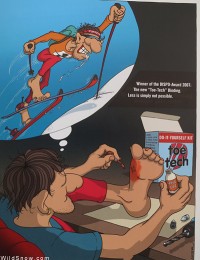
Cartoon by Georg Sojer, caption reads: 'Winner of the DISPO-Award 2007: The new 'Toe-Tech' Binding. Less is simply not possible.' (Click image to enlarge)
More humor ensues. Larded throughout the 184 page large-format tome you’ll find a series of cartoons drawn by Georg Sojer. These hilarious takes vary from Dynafit bindings being used for a mouse trap, to a guy cutting up his wife’s fur coat for skin material.
Keeping the book organized, nearly every page has a date in the upper corner. Most of the content is in the form of long and short anecdotes by Dynafit binding users over the past three decades. The majority of these are quite funny, or immensely interesting — or even poignant. Such as Alberto Paleari’s account of how one of his guiding clients recommended the bindings to him. The guy was an older, out-of-shape engineer — who chose the “mini binding because he was an engineer, he understood and loved strong but light mechanisms, simple functional and elegant solutions. I don’t have enough time to tell of the adventures we had in the mountains together…”
Memorials to Dynafit athletes such as Steve Romeo and Tomas Olsson bring it all home. The account of Olsson is written by his Everest ski attempt climbing partner Tormod Granheim, and describes in detail how the “best day of my life…was also the worst day of my life…when entering the Norton Couloir, Tomas broke a ski…” It’s intense but real, and balances out some of the overtly commercial aspects of the book.
But even the commercialism pulls through. For example, on pages 174-177 you’ll find a historical illustrated guide to the history of the Low-Tech Dynafit bindings — 35 models! Turn the page, and you get the whole story of Dynafit, on a timeline showing how Humanic boot company began in 1950 in Graz, Austria, leading to the Dynafit brand being created in 1975, and so on. Somewhat business-to-business, yet important history to the development of ski touring over the years.
Downsides for my worshipful critique of the book about the best ski binding of the past 30 years? To make this more useful in the historical record, they could have put in a table of contents and an index! But having helped a bit with the translations from German to English I’ll even give that a pass. I can’t conceive of how much work it must have been for individuals such as Therese Iknoian to do tens of thousands of words of translation — including ski touring slang. Props to the translators! So last crit: should have had a credits page for all the folks who made this happen.
In all, 184 pages of compelling content. Breaks the mold of “brand books” for sure, and worth acquiring for any collection of ski mountaineering related literature.
Part Two, my own story of Dynafit ski bindings.
(“30 Years Dynafit Tech Bindings” is not planned for retail sales at this time but can probably be acquired through reps or dealers if you work at it. It is bar coded, so I’m taking that as a hint that with enough demand we might someday see it on Amazon. A German version is in production as well as the existing English version.)
WildSnow.com publisher emeritus and founder Lou (Louis Dawson) has a 50+ years career in climbing, backcountry skiing and ski mountaineering. He was the first person in history to ski down all 54 Colorado 14,000-foot peaks, has authored numerous books about about backcountry skiing, and has skied from the summit of Denali in Alaska, North America’s highest mountain.

